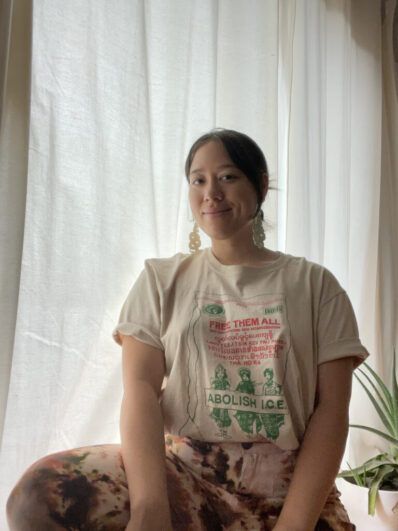interview by Kylie Volavongsa

Kat Eng is a mixed second-generation Khmer artist, organizer, and visual storyteller. Their narrative and documentary projects explore the loss, belonging, and relationships with land. Past project partners have included the Minnesota Museum of American Art, zAmya Theater, the Land Stewardship Project, and the Asian Prisoner Support Committee. This year, Kat created the artwork for SEARAC’s 2021 Annual Report. We wanted to create space for Kat to share more about their background and their work.
What are your biggest sources of inspiration?
When I look for inspiration for my design projects, I often refer to the primary palettes and geometric layouts of early 19th century propaganda. I strive for simplicity, but I want to live in the verdant landscapes of Studio Ghibli films. I also have a memory from childhood of sitting on a chair from somewhere in Mexico, painted with animals in bright flat shapes detailed with contrasting colors. While my style has changed and evolved over the years, I think the influence of that chair’s magical linework has stuck with me.
What is your favorite medium to work with, and how did you come to work with it?
Digitally I mostly use Procreate, but I work in a lot of mediums: I paint with watercolors, make collages out of old national geographics, and explore a lot of ideas through film, photography, and puppetry, but I sometimes get the most enjoyment out of doodling on a napkin with whatever pen is laying around 🙂
How does your creative process generally look?
I use artmaking as a way to digest current events/cycles of bad news. It feels like one of the few tools that is empowering in the face of the endless violence of this world.
I often kickstart my projects by tracing, drawing from life, or working with found objects. I take a lot of reference photos while walking around, trying to capture moments of sunlight, forgotten belongings and places, the tenacity of weeds.
What are some moments that you’re the most proud of as an artist and why?
A few years ago when ICE began ramping up attacks on Southeast Asian refugees, I drew a design reimagining the iconic Three Ladies from the jasmine rice bags as freedom fighters for the diaspora. At the time, there wasn’t as much public awareness about how targeted our communities were becoming. I had a lot of help from friends and colleagues to translate “Free Them All” in Hmong, Khmer, Lao, and Vietnamese, and we added Burmese in 2021.
The first print run was for folks at The Fang Collective who wore the shirts while blockading county jails operating as ICE facilities in Massachusetts (and helped win the fight to cancel those federal contracts!). Since then, it’s been an honor to share this Abolish (r)I.C.E. design to support work at Release MN 8, VietUnity, the Black Immigrant Collective, Asian Prisoner Support Committee, the Long Beach Southeast Asian Anti-Deportation Collective, and with other people fighting deportation all across the country.
How does your identity — especially as a Southeast Asian — inform your work?
My dad came to Minneapolis in 1979 as a refugee from Cambodia, where he lost his entire family. I grew up in rural Minnesota, where for many years the only Asian people I knew were my dad and my sister. I think that many refugee families share the experience of having to navigate feelings about belonging every day. Drawing was (and still is) a way for me to explore lost histories and imagine the sort of world I’d like to live in. I have found so much joy in creating and sharing art that helps me connect with other people in our community.
Learn more about Kat Eng at www.kateng.co.
